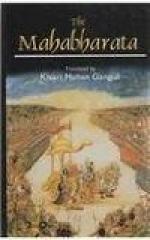apes. Repairing then into the presence of that
foremost of men, viz., my father, of my mother,
of the king, and of Ahuka, I informed them of what
the daughter of the prince of the Vidyadharas, in
great affliction, had said unto me. Bidding them
farewell with a sorrowful heart, I then repaired to
Gada and to Rama of great might. These two cheerfully
addressed me saying,—Let thy penances increase
without any obstruction.—Having obtained
the permission of all of them, I thought of Garuda.
He immediately came to me and bore me to Himavat (at
my bidding). Arrived at Himavat, I dismissed him.
There on that foremost of mountains, I beheld many
wonderful sights. I saw an excellent, wonderful,
and agreeable retreat for the practice of penances.
That delightful retreat was owned by the high-souled
Upamanyu who was a descendant of Vyaghrapada.
That retreat is applauded and reverenced by the deities
and the Gandharvas, and seemed to be covered with Vedic
beauty. It was adorned with Dhavas and Kakubhas
and Kadamvas and Cocas, with Kuruvakas and Ketakas
and Jamvus and Patalas, with banians and Varunakas
and Vatsanabhas and Vilwas, with Saralas and Kapitthas
and Piyalas and Salas and palmyras with Vadaris and
Kundas and Punnagas and Asokas and Amras and Kovidaras
and Champakas and Panasas, and with diverse other
trees endued with fruits and flowers. And that
retreat was also decked with the straight stems of
the Musa Supienta.[37] Truly, that asylum was adorned
with diverse other kinds of trees and with diverse
kinds of fruits forming the food of diverse kinds of
birds. Heaps of ashes (of sacrificial fires)
were thrown in proper places all around, which added
to the beauty of the scene. It abounded with Rurus
and apes and tigers and lions and leopards, with deer
of diverse species and peacocks, and with cats and
snakes. Indeed, large numbers of other animals
also were seen there, as also buffaloes and bears.
Delicious breezes constantly blew bearing the melodious
strains of celestial nymphs. The babblings of
mountain rivulets and springs, the sweet notes of
winged choristers, the gruntings of elephants, the
delicious stains of Kinnaras, and the auspicious voice
of ascetics singing the Samans, O hero, and diverse
other kinds of music, rendered that retreat extremely
charming. The very imagination cannot conceive
another retreat as delightful as the one I beheld.
There were also large houses in that asylum, intended
for keeping the sacred fire, and covered all over with
flowering creepers. It was adorned with the river
Ganga of clear and sacred water. Indeed, the
daughter of Jahnu always remained there. It was
decked also with many ascetics who were the foremost
of all righteous persons, who were endued with high
souls, and who resembled fire itself in energy.[38]
Some of those ascetics subsisted upon air and some
upon water, some were devoted to Japa or the silent
recitation of sacred Mantras, and some were engaged
in cleansing their souls by practising the virtues




